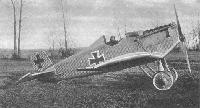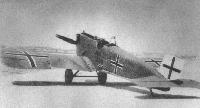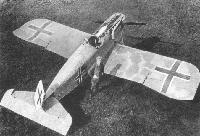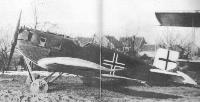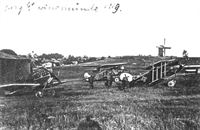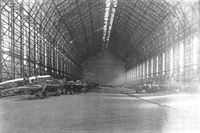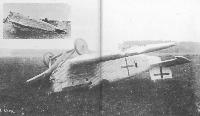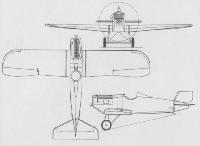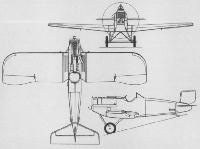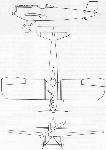
Описание
Страна: Германия
Год: 1918
Истребитель
В.Кондратьев Самолеты первой мировой войны
"ЮНКЕРС" D.I / JUNKERS D.I
Первый в мире цельнометаллический истребитель, построенный по прогрессивной схеме свободнонесущего низкоплана, был разработан в КБ фирмы "Юнкерс Флюгцойгверк" весной 1918 года на базе экспериментального одноместного моноплана J7. Новый самолет получил заводской индекс J9. Его фюзеляж, крыло и оперение имели каркас, склепанный из дюралевых труб и обшивку из тонких листов гофрированного металла. Двигатель - "Мерседес" D-III мощностью 160 л.с. Вооружение - два синхропулемета LMG 08/15.
J9 впервые поднялся в воздух 12 мая 1918 г. и в следующем месяце принял участие во втором конкурсе истребителей в Адлерсхофе. Самолет показал неплохие скоростные данные, но по маневренности он уступал новым истребителям бипланной схемы, а летчики жаловались на "вялое" управление и недостаточный обзор вниз. Однако важным достоинством машины посчитали ее очень прочную и выносливую конструкцию, которая согласно прогнозам должна была выдерживать значительные боевые повреждения и хорошо противостоять атмосферным воздействиям.
Фирме оплатили постройку 100 экземпляров истребителя, однако из-за различных технических проблем, а также из-за перебоев с поставками двигателей, сырья и комплектующих до конца войны успели построить и сдать военной приемке всего девять машин. Еще 31 экземпляр был выпущен уже после окончания боевых действий - с ноября 1918-го по февраль 1919 г. 12 из них сделаны по лицензии на фирме "Фоккер".
Первые три "юнкерса" D.I отправили на западный фронт в августе 1918-го, еще три - в октябре, но никаких данных об их боевом применении не сохранилось.
В 1919 году металлические "юнкерсы" активно использовались немецким добровольческим корпусом в гражданской войне на территории Прибалтики. В ходе боев полностью подтвердилось мнение об их выносливости и высокой боевой живучести.
ДВИГАТЕЛЬ: "Мерседес" D.III (180 л.с.) или BMW IIIa (185 л.с.).
ВООРУЖЕНИЕ: 2 синхр. LMG 08/ 15 "Шпандау".
ЛЕТНО-ТЕХНИЧЕСКИЕ ХАРАКТЕРИСТИКИ
Размах, м 9,00
Длина, м, 7,30 (6,70)
Площадь крыла, кв.м 14,80
Сухой вес, кг 654
Взлетный вес, кг 834
Скорость максимальная, км/ч 186
Время подъема на высоту
1000 м, мин. сек 2,30
Потолок, м 6000
Описание:
- В.Кондратьев Самолеты первой мировой войны
- A.Kay Junkers Aircraft and Engines 1913-1945 (Putnam)
- O.Thetford, P.Gray German Aircraft of the First World War (Putnam)
- W.Green, G.Swanborough The Complete Book of Fighters
- M.Dusing German Aviation Industry in WWI. Volume 1 (A Centennial Perspective on Great War Airplanes 84)
Фотографии
-
В.Кондратьев - Самолеты первой мировой войны
"Юнкерс" D.I, захваченный англичанами во Фландрии в октябре 1918г.
-
В.Кондратьев - Самолеты первой мировой войны
Юнкерс D.I, осень 1918г.
-
A.Kay - Junkers Aircraft and Engines 1913-1945 /Putnam/
The Junkers J7 was the world's first all-Duralumin fighter. Dated 13 September 1917, this photograph shows the sole prototype with rotating wing tips for roll control.
-
J.Herris - Weird Wings of WWI /Centennial Perspective/ (70)
Made of duralimin, an aluminum alloy, the Junkers J 7 fighter prototype as originally built with rotating wing-tip ailerons. A sturdy roll-over structure was enclosed by the streamlined headrest. The radiator was mounted over the engine to expedite flight testing while investigation into the ultimate configuration of the nose radiator mounting continued. A long exhaust pipe was fitted.
-
H.Cowin - Aviation Pioneers /Osprey/
While Reuter and his team followed Hugo Junker's concept to the letter, their notions of construction engineering owed more to bridge building than aviation practice. They showed a marked reluctance to switch from steel to light alloy, despite the fact that Zeppelin had been using it since 1908, or thereabouts. Perhaps the finest example of this is the Junkers J.7 experimental single seat fighter first flown in early September 1917. In its initial form, as photographed in flight, the machine was an aerodynamic and fighter pilot's nightmare, with a radiator towering above the engine, not only creating a huge drag, but totally obscuring forward pilot visibility. At this time, the J.7 also had swivelling wingtips in place of the standard ailerons.
-
J.Herris - Weird Wings of WWI /Centennial Perspective/ (70)
The Junkers J 7 prototype photographed on October 12, 1917, after being fitted with a new wing using conventional ailerons. The long exhaust pipe and test equipment are still fitted, and the original radiator was still mounted over the 160 hp Mercedes D.III. A neat spinner is fitted over the propeller hub.
-
Jane's All The World Aircraft 1919 /Jane's/
The Junkers J.7 experimental all-metal fighter of 1917, developed into the operational D.I of 1918.
-
M.Dusing - German Aviation Industry in WWI. Volume 1 /Centennial Perspective/ (84)
The ground-based image shows the same aircraft some 15 months later and looking almost indistinguishable from the prototype D I fighter, many of whose features had been evolved thanks to the J.7.
The J 7 with definitive wing proved faster than all other contenders in the first D-type contest. -
J.Herris - Weird Wings of WWI /Centennial Perspective/ (70)
The Junkers J 7 prototype in its third configuration photographed January 1918 while being readied for the First Fighter Competition. It now has yet another new wing with aerodynamically-balanced ailerons, and a nose-mounted radiator. The spinner and the long exhaust pipe are both gone and it has a new rudder.
-
В.Кондратьев - Самолеты первой мировой войны
Экспериментальный истребитель J9 - прототип "Юнкерса" D.I.
-
J.Herris - Weird Wings of WWI /Centennial Perspective/ (70)
The Junkers J 7 prototype photographed on February 2, 1918, in its fourth configuration after being fitted with yet another new wing of longer span. The ailerons are also longer and no longer have aerodynamic balances. Test equipment are still fitted. The test pilot was Arved Schmidt.
-
J.Herris - Weird Wings of WWI /Centennial Perspective/ (70)
The Junkers J 7 prototype in its fifth configuration photographed March 23, 1918 with larger radiator for summer operation. The aircraft was accepted by Idflieg for demonstrations and training the week of March 25, 1918.
-
A.Kay - Junkers Aircraft and Engines 1913-1945 /Putnam/
By 12 October 1917 the J7 fighter had been fitted with conventional, unbalanced ailerons.
-
J.Herris - Weird Wings of WWI /Centennial Perspective/ (70)
The Junkers J 7 prototype in its fifth configuration photographed March 23, 1918 with larger radiator for summer operation. The aircraft was accepted by Idflieg for demonstrations and training the week of March 25, 1918.
-
Jane's All The World Aircraft 1919 /Jane's/
A rear view of the Junkers J.7 Monoplane.
-
В.Кондратьев - Самолеты первой мировой войны
Прототип "Юнкерса" D.I в фиолетово-зеленом камуфляже
-
В.Кондратьев - Самолеты первой мировой войны
Серийный "Юнкерс" D.I в военном камуфляже.
-
A.Kay - Junkers Aircraft and Engines 1913-1945 /Putnam/
The J9 of 1918, with its corrugated skin, did not fare well in a fighter contest but was nevertheless put into production.
The Junkers D.I was the world's first production all-metal fighter and was just entering service at the end of the war. A very fast airplane for its time with maximum speed of 240 km/h (148 mph), its low-wing monoplane configuration foretold the future. Power was a 180 hp BMW .IIIa engine. -
W.Green, G.Swanborough - The Complete Book of Fighters
The short-fuselage version of the J 9 (D I) photographed fully armed on 8 July 1918.
-
J.Herris - Weird Wings of WWI /Centennial Perspective/ (70)
The Junkers J 9/1 production prototype of the Junkers D.I was photographed July 8, 1918 at the Junkers airfield at Dessau. The Junkers D.I was the first production all-metal fighter. It was actually lighter than the competing Fokker V21 and V23 monoplane fighters made of wood!
-
H.Cowin - Aviation Pioneers /Osprey/
Developed as a synthesis of both the Junkers J.7 single seater and J.8 two seater, the short-fuselaged prototype J.9 rolled out of the Junkers plant at the end of April 1918. Powered by a 185hp BMW IIIa, this unarmed, light alloy machine achieved a remarkable top level speed of 149mph at sea level. Surprisingly, the top level speed of the definitive, long-fuselaged, armed production J.9, was only 4mph slower, at 145mph. In a classic case of bi-focal thinking the military gave the J.9 the designation Junkers D I, where D stood for Doppledecker, or biplane, as they had with Fokker's D VIII. Depicted here is a recently ex-factory D I awaiting delivery on 8 July 1918. As already mentioned with reference to the Junkers J.4/J I, production engineering was the company's real weakness and only a handful of the 41 completed twin 7.92mm Spandau-armed single seaters were to reach the Western Front prior to the Armistice. Junkers D Is, however, did manage to find their way into Poland and the Baltic States, where they continued to fly and fight, along with their two seat Junkers CL I bretheren with the Geschwader Sachenberg. / "Юнкерс" D.I c мотором BMW-IIIa, принимавший участие в конкурсе перспективных моделей истребителей в Адлерсхофе.
-
H.Cowin - Aviation Pioneers /Osprey/
Photographed in a Belgium field on 21 January 1919, this all-metal Junkers D I was still deemed to be basically airworthy after being abandoned in the open for more than three months. Four Fokker D VIIs on the same site had deteriorated beyond repair.
-
R.Bennett - Last Gathering of Eagles 1918-1920 /Aeronaut/
Lineup of Junkers D.Is at Peterfeld, 9 October 1919, the day after Bermondt launched his ill-fated assault on Riga.
-
R.Bennett - Last Gathering of Eagles 1918-1920 /Aeronaut/
Erich Schaefer (third from right) and Ju. D.I 3188/18 at Peterfeld, 9 October 1919. A Fokker D.VII is in the background.
Другие самолёты на фотографии: Fokker D.VII / V11 / V18 / V22 / V24 - Германия - 1917
-
R.Bennett - Last Gathering of Eagles 1918-1920 /Aeronaut/
Propping a Ju.D.I at Wainoden. The airship docking rail made a useful wheel chock.
Kampfgeschwader Sachsenberg's first base was the airship station at Wainoden in Kurland. Equipped with the latest products of the German aviation industry and using Schlachtstaffel tactics, it provided valuable support for the ground forces. Here using the airship shed guidance rails as chocks is a Junkers D I all-metal cantilever single-seater, with an LVG C VI and two Junkers CL I two-seaters in the background.Другие самолёты на фотографии: Junkers CL.I / J 8 / J 10 - Германия - 1918LVG C.VI - Германия - 1918
-
R.Bennett - Last Gathering of Eagles 1918-1920 /Aeronaut/
Ex-Sachsenberg aircraft at Peterfeld - a Ju D.I, two SSW D.IVs, an LVG C.VI, and two others, one of which appears to be an Albatros D.V. The LVG is marked with the letter "M", similar to the one applied to one of the Geschwader's Junkers CL.Is.
Другие самолёты на фотографии: LVG C.VI - Германия - 1918Siemens-Schuckert D.II/D.III/D.IV - Германия - 1917
-
J.Herris - Halberstadt Aircraft of WWI. Volume 2: CL.IV-CLS.I & Fighters /Centennial Perspective/ (45)
Junkers D.I, Fokker D.VIIs, Halberstadt C.V, and LVG C.VI (?) at Swinemunde (today's Swinoujscie, in Poland) on the Baltic in 1919. This gathering of aircraft is said to belong to the Sachsenberg Geschwader. If so, the summer foliage indicates this photo was probably taken in late August or September, during a stopover in the unit's return to its old leader in Kurland.
Другие самолёты на фотографии: Fokker D.VII / V11 / V18 / V22 / V24 - Германия - 1917Halberstadt C.V/C.IX - Германия - 1918
-
J.Herris - Halberstadt Aircraft of WWI. Volume 2: CL.IV-CLS.I & Fighters /Centennial Perspective/ (45)
Halberstadt C.V is among Junkers monoplanes and a Fokker D.VII on the right of the Wainoden Zeppelin hall postwar. Junkers D.I(Jco) D.9166/18 is first in line on the left. This location is now Vainode in Latvia. (Peter M. Grosz collection/STDB)
Другие самолёты на фотографии: Fokker D.VII / V11 / V18 / V22 / V24 - Германия - 1917Halberstadt C.V/C.IX - Германия - 1918
-
J.Herris - Weird Wings of WWI /Centennial Perspective/ (70)
The Junkers J 9/II prototype was powered by the experimental 195 hp Benz Bz.IIIbo un-geared V-8 engine. Intended to compete at the Second Fighter Competition, the unreliable engine prevented its appearance. The under-fuselage radiator was modern for its time.
-
A.Kay - Junkers Aircraft and Engines 1913-1945 /Putnam/
The Junkers J9 (DI) fighter, showing the nine ball joint sockets for wing attachment at each side, later to become the standard Junkers method of attachment.
-
M.Dusing - German Aviation Industry in WWI. Volume 1 /Centennial Perspective/ (84)
Loading Junkers J.9 (D.I) for the front line.
-
R.Kosin - The German Fighter since 1915 /Putnam/
Junkers single-seater, fuselage framework made of open dural profile strip, before attachment of corrugated sheet metal skin.
-
H.Cowin - Aviation Pioneers /Osprey/
The first of a small number of pre-production Junkers D I single seat fighters was completed at the end of April 1918. The short fuselage seen on this aircraft was replaced by a longer one on the 41 production D Is. Powered by a 185hp BMW IIIa, the production examples had a top level speed of 145mph, along with an operational ceiling of 19,700 feet. The interesting thing about the image of a D I after it had suffered a nose-over accident at speed, following a landing gear collapse, is the comparatively light damage sustained. This and other D Is used for service evaluation in the last weeks of the war flew with a non-standard natural metal finish.
-
W.Green, G.Swanborough - The Complete Book of Fighters
The Junkers J 7 in its definitive form.
-
W.Green, G.Swanborough - The Complete Book of Fighters
The early-production short-fuselage J 9, found unsuited for contemporary fighter tactics.
-
R.Kosin - The German Fighter since 1915 /Putnam/
Junkers J 9 (J.I)
-
В.Кондратьев - Самолеты первой мировой войны
Junkers D.I










